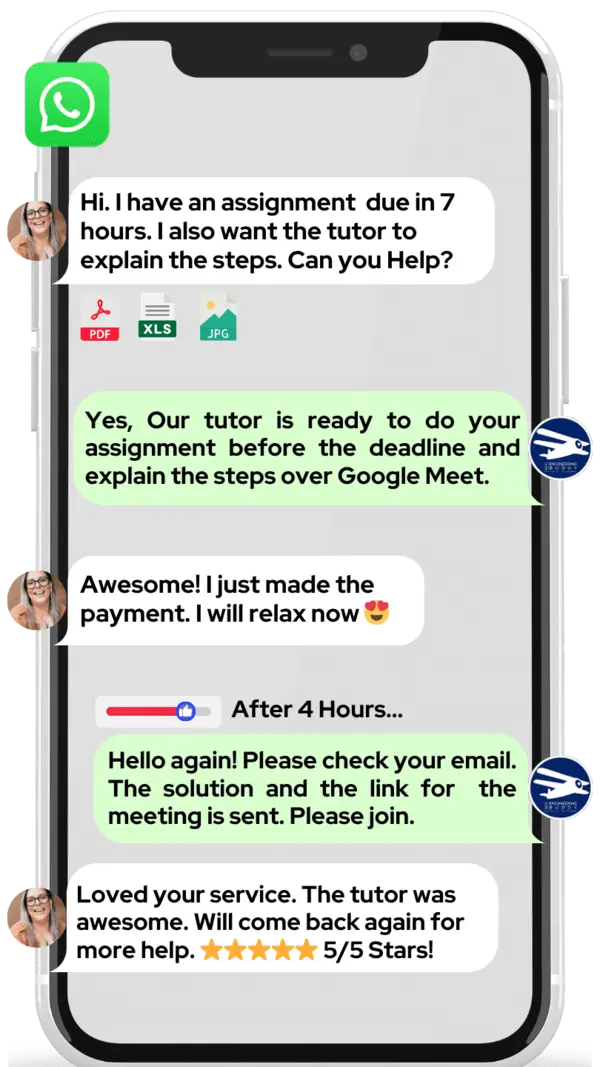

Hire The Best Aircraft Design Tutor
Top Tutors, Top Grades. Without The Stress!
10,000+ Happy Students From Various Universities
Choose MEB. Choose Peace Of Mind!
How Much For Private 1:1 Tutoring & Hw Help?
Private 1:1 Tutors Cost $20 – 35 per hour* on average. HW Help cost depends mostly on the effort**.
Aircraft Design Online Tutoring & Homework Help
What is Aircraft Design?
Aircraft design is the systematic process of defining the shape, structure, and systems of an airplane or rotorcraft to meet performance, safety, and cost objectives. It involves aerodynamic analysis using Computational Fluid Dynamics (CFD), structural sizing with Computer‑Aided Design (CAD), systems integration and trade studies—like optimizing the wing layout on a Boeing 737 for fuel efficiency or refining the fuselage of a private jet for cabin comfort.
Also called aerospace vehicle design, aeronautical engineering design, airplane configuration design, or flight vehicle design.
Key topics include aerodynamics (lift, drag, flutter in wind‑tunnel tests or RC models), propulsion (turbofan engines on airliners or rocket motors on spaceplanes), structures and materials (composite panels on fighters), flight mechanics (stability, control laws), performance (range, payload), weight and balance, systems integration (avionics, hydraulics), manufacturability and cost analysis.
The Wright brother’s first powered flight at Kitty Hawk in 1903 kicked everything off. By World War I biplane designs were evolving rapidly, and in the 1930s Frank Whittle and Hans von Ohain developed the first jet engines. Chuck Yeager broke the sound barrier in the Bell X‑1 in 1947. In the 1960s composite materials like fiberglass and carbon fiber emerged. CAD tools became indispensible in the 1980s, enabling virtual prototypes. Airbus introduced fly‑by‑wire on the A320 in 1988, and since then unmanned aerial vehicles and electric propulsion have propelled design into a new era.
How can MEB help you with Aircraft Design?
Do you want to learn how to design airplanes? We at MEB provide one‑on‑one online Aircraft Design tutoring. A tutor will work with you step by step.
If you are a school, college, or university student and need top grades on assignments, lab reports, live assessments, projects, essays, or dissertations, try our 24/7 online Aircraft Design homework help. We prefer to chat on WhatsApp. If you don’t use WhatsApp, please email us at meb@myengineeringbuddy.com.
Our services are open to everyone, but most of our students come from the USA, Canada, UK, Gulf countries, Europe, and Australia.
Students ask us for help when: • Subjects are hard to learn • There are too many assignments • Questions and concepts seem too complex • Health or personal issues get in the way • They have part‑time work or missed classes • They need more time to keep up with the pace
If you are a parent and your ward is struggling with Aircraft Design, contact us today. Our tutors can help them ace exams and homework. They will thank you!
MEB also offers support in over 1000 other subjects. Our expert tutors are ready to help you learn more easily and succeed in school. It’s smart to ask a tutor for help when you need it and enjoy a stress‑free academic life.
DISCLAIMER: OUR SERVICES AIM TO PROVIDE PERSONALIZED ACADEMIC GUIDANCE, HELPING STUDENTS UNDERSTAND CONCEPTS AND IMPROVE SKILLS. MATERIALS PROVIDED ARE FOR REFERENCE AND LEARNING PURPOSES ONLY. MISUSING THEM FOR ACADEMIC DISHONESTY OR VIOLATIONS OF INTEGRITY POLICIES IS STRONGLY DISCOURAGED. READ OUR HONOR CODE AND ACADEMIC INTEGRITY POLICY TO CURB DISHONEST BEHAVIOUR.
What is so special about Aircraft Design?
Aircraft design stands out because it blends creativity with hard science. Students learn aerodynamics, materials, structures and systems together. They imagine new shapes then test how they fly. This unique mix of art and physics makes designing planes special and rewarding. Safety rules and real-world limits push students to think carefully. Every choice affects fuel use, cost and performance. That complex challenge sets aircraft design apart.
Compared to other engineering subjects, aircraft design offers clear real-world impact. Students see how their ideas shape a flying machine, boosting motivation. It opens doors to high-paying aerospace jobs and cutting-edge research. The downside is heavy math, strict safety rules, and steep learning curves. Complex software and long development times can feel overwhelming. Yet, the thrill of flight keeps many hooked.
What are the career opportunities in Aircraft Design?
Many students move on from an undergraduate degree in Aircraft Design to specialized master’s programs in areas like aerodynamics, propulsion, lightweight structures or computational fluid dynamics. Some also pursue doctoral studies to lead research in new materials, electric flight or supersonic travel.
The career landscape for Aircraft Design graduates is growing with trends such as unmanned aerial vehicles, urban air mobility and green aviation. Engineers are in demand at commercial plane makers, defense contractors, space companies and start‑ups focused on hydrogen or battery‑powered flight.
Popular roles include Aircraft Design Engineer, who creates and tests new wing or fuselage shapes; Stress Analyst, who checks that structures can handle loads; Aerodynamicist, who uses wind‑tunnel and computer models; and Systems Integrator, who makes sure all parts work together. Work often involves CAD modeling, simulation and teamwork.
We study and prepare for Aircraft Design to build strong skills in math, physics and software tools. This training helps ensure safety, efficiency and cost control in real aircraft programs. It also readies students for licensing exams and fast‑changing tech in aviation.
How to learn Aircraft Design?
Start by building a strong foundation in aerodynamics, structures, propulsion and flight controls. Step 1: review basic math and physics. Step 2: study core theory from textbooks or online lectures. Step 3: practice simple design problems—wing sizing, lift estimation, weight balance. Step 4: learn to use design tools like XFLR5, OpenVSP or MATLAB for calculations. Step 5: analyze your results, identify mistakes, and iterate. Consistent practice and gradual complexity help you master aircraft design principles.
Aircraft Design can seem tough because it combines many engineering areas at once. You’ll face challenging math, detailed calculations and design trade‑offs. But if you break tasks into clear steps, use good references and practice regularly, it becomes manageable. Persistence and hands‑on projects turn complexity into learning opportunities, making each new concept feel less daunting.
You can self‑study many aspects of Aircraft Design using textbooks, tutorials and software guides. However, a tutor speeds up your progress by explaining tricky topics, giving personalized feedback and keeping you on track. If you ever get stuck on aerodynamic theory, structural analysis or software workflows, a tutor ensures you don’t waste time spinning wheels and helps you build confidence.
MEB offers 24/7 online one‑to‑one tutoring and assignment help for Aircraft Design at student‑friendly rates. Our aerospace‑qualified tutors guide you through theory, software tools and design projects, review your work, and prepare you for exams or assignments. Whether you need scheduled lessons or last‑minute clarifications, our team is ready to support you and boost your understanding or grades.
Learning basic Aircraft Design concepts typically takes 3–6 months of regular study for undergraduates to grasp fundamentals. Achieving deeper proficiency and handling full design projects can take 1–2 years of coursework and practical work. Your pace depends on prior knowledge, study hours per week and project complexity—consistent effort and expert guidance can shorten this timeline.
Popular YouTube channels include FlightMechanics101 for design lectures, MIT OpenCourseWare’s Aircraft Dynamics series, Real Engineering for concept overviews, and MentorPilot for flight test insights. Key websites are NASA Technical Reports Server, NACA archives, MIT OpenCourseWare, Coursera’s aerospace courses and University of Toronto flight research pages. Essential textbooks are Daniel Raymer’s "Aircraft Design: A Conceptual Approach", John D. Anderson’s "Fundamentals of Aerodynamics", Etkin and Reid’s "Dynamics of Flight" and Bruhn’s "Analysis and Design of Flight Vehicle Structures".
College students, parents and tutors from the USA, Canada, UK, Gulf and beyond—if you need a helping hand, whether it’s 24/7 one‑on‑one tutoring or assignment support, our tutors at MEB can help at an affordable fee.































